Emotional Intelligence-psychological Measure Assignment 2022
VerifiedAdded on 2022/09/21
|7
|1925
|21
Assignment
AI Summary
Contribute Materials
Your contribution can guide someone’s learning journey. Share your
documents today.
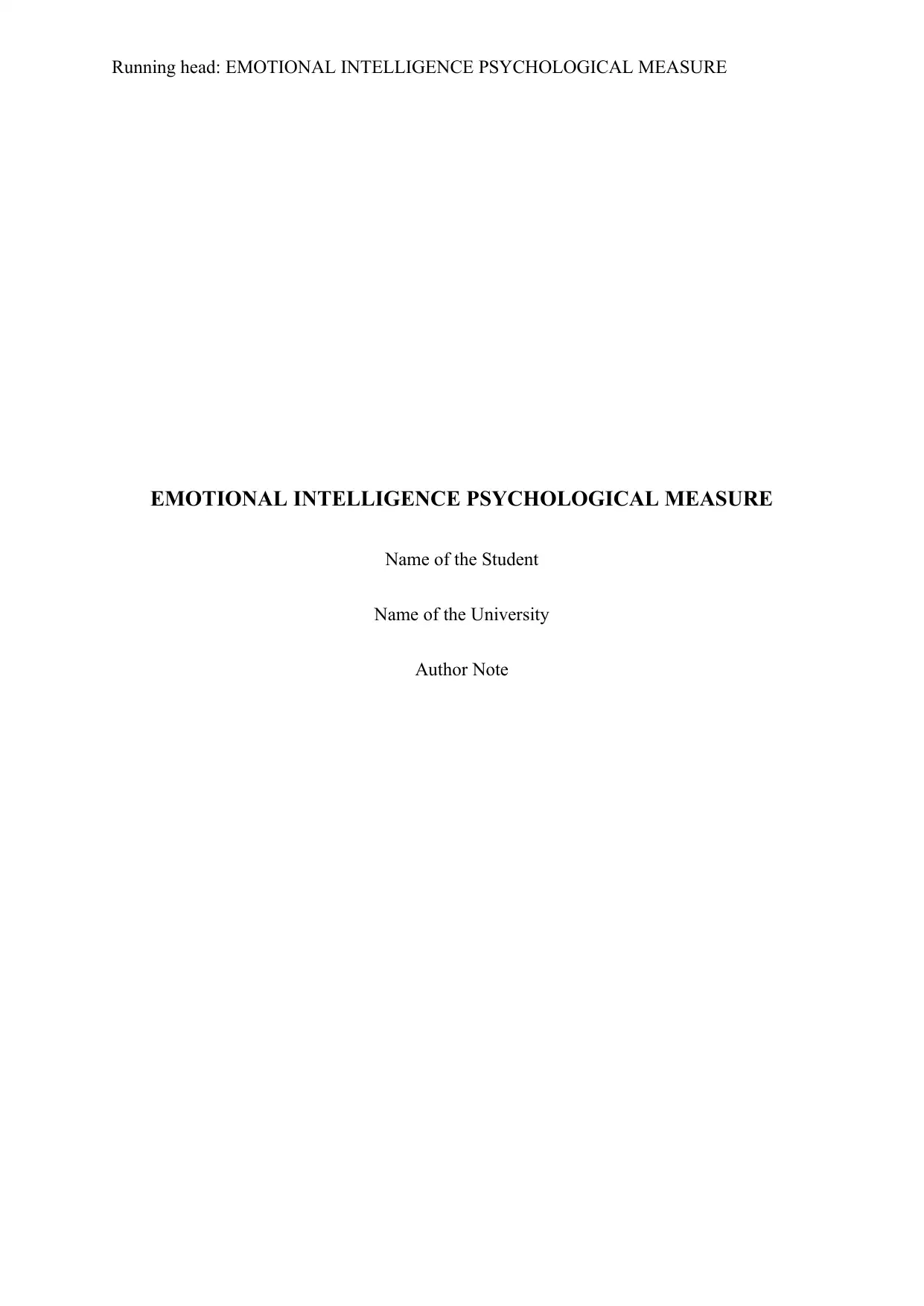
Running head: EMOTIONAL INTELLIGENCE PSYCHOLOGICAL MEASURE
EMOTIONAL INTELLIGENCE PSYCHOLOGICAL MEASURE
Name of the Student
Name of the University
Author Note
EMOTIONAL INTELLIGENCE PSYCHOLOGICAL MEASURE
Name of the Student
Name of the University
Author Note
Secure Best Marks with AI Grader
Need help grading? Try our AI Grader for instant feedback on your assignments.
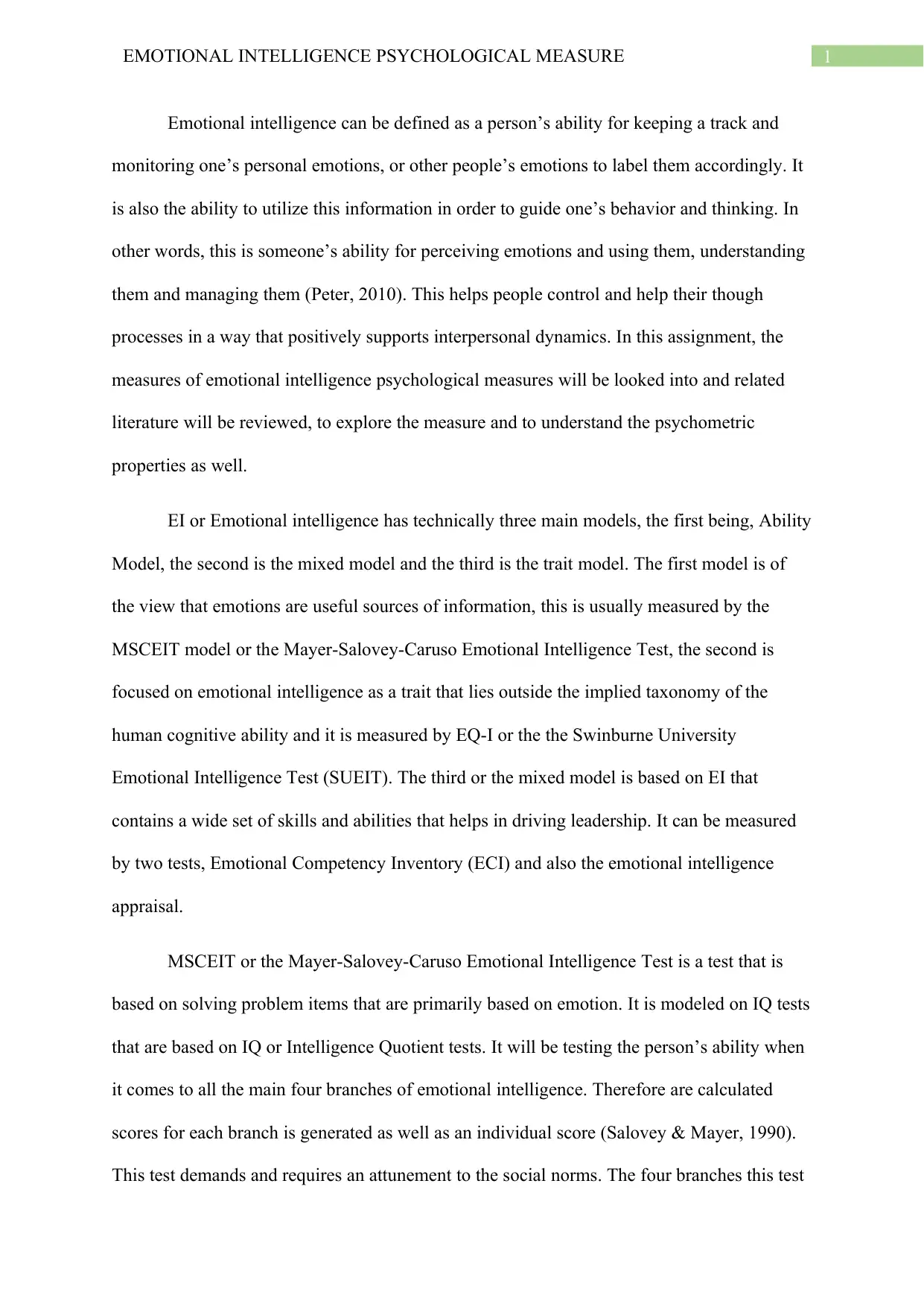
1EMOTIONAL INTELLIGENCE PSYCHOLOGICAL MEASURE
Emotional intelligence can be defined as a person’s ability for keeping a track and
monitoring one’s personal emotions, or other people’s emotions to label them accordingly. It
is also the ability to utilize this information in order to guide one’s behavior and thinking. In
other words, this is someone’s ability for perceiving emotions and using them, understanding
them and managing them (Peter, 2010). This helps people control and help their though
processes in a way that positively supports interpersonal dynamics. In this assignment, the
measures of emotional intelligence psychological measures will be looked into and related
literature will be reviewed, to explore the measure and to understand the psychometric
properties as well.
EI or Emotional intelligence has technically three main models, the first being, Ability
Model, the second is the mixed model and the third is the trait model. The first model is of
the view that emotions are useful sources of information, this is usually measured by the
MSCEIT model or the Mayer-Salovey-Caruso Emotional Intelligence Test, the second is
focused on emotional intelligence as a trait that lies outside the implied taxonomy of the
human cognitive ability and it is measured by EQ-I or the the Swinburne University
Emotional Intelligence Test (SUEIT). The third or the mixed model is based on EI that
contains a wide set of skills and abilities that helps in driving leadership. It can be measured
by two tests, Emotional Competency Inventory (ECI) and also the emotional intelligence
appraisal.
MSCEIT or the Mayer-Salovey-Caruso Emotional Intelligence Test is a test that is
based on solving problem items that are primarily based on emotion. It is modeled on IQ tests
that are based on IQ or Intelligence Quotient tests. It will be testing the person’s ability when
it comes to all the main four branches of emotional intelligence. Therefore are calculated
scores for each branch is generated as well as an individual score (Salovey & Mayer, 1990).
This test demands and requires an attunement to the social norms. The four branches this test
Emotional intelligence can be defined as a person’s ability for keeping a track and
monitoring one’s personal emotions, or other people’s emotions to label them accordingly. It
is also the ability to utilize this information in order to guide one’s behavior and thinking. In
other words, this is someone’s ability for perceiving emotions and using them, understanding
them and managing them (Peter, 2010). This helps people control and help their though
processes in a way that positively supports interpersonal dynamics. In this assignment, the
measures of emotional intelligence psychological measures will be looked into and related
literature will be reviewed, to explore the measure and to understand the psychometric
properties as well.
EI or Emotional intelligence has technically three main models, the first being, Ability
Model, the second is the mixed model and the third is the trait model. The first model is of
the view that emotions are useful sources of information, this is usually measured by the
MSCEIT model or the Mayer-Salovey-Caruso Emotional Intelligence Test, the second is
focused on emotional intelligence as a trait that lies outside the implied taxonomy of the
human cognitive ability and it is measured by EQ-I or the the Swinburne University
Emotional Intelligence Test (SUEIT). The third or the mixed model is based on EI that
contains a wide set of skills and abilities that helps in driving leadership. It can be measured
by two tests, Emotional Competency Inventory (ECI) and also the emotional intelligence
appraisal.
MSCEIT or the Mayer-Salovey-Caruso Emotional Intelligence Test is a test that is
based on solving problem items that are primarily based on emotion. It is modeled on IQ tests
that are based on IQ or Intelligence Quotient tests. It will be testing the person’s ability when
it comes to all the main four branches of emotional intelligence. Therefore are calculated
scores for each branch is generated as well as an individual score (Salovey & Mayer, 1990).
This test demands and requires an attunement to the social norms. The four branches this test
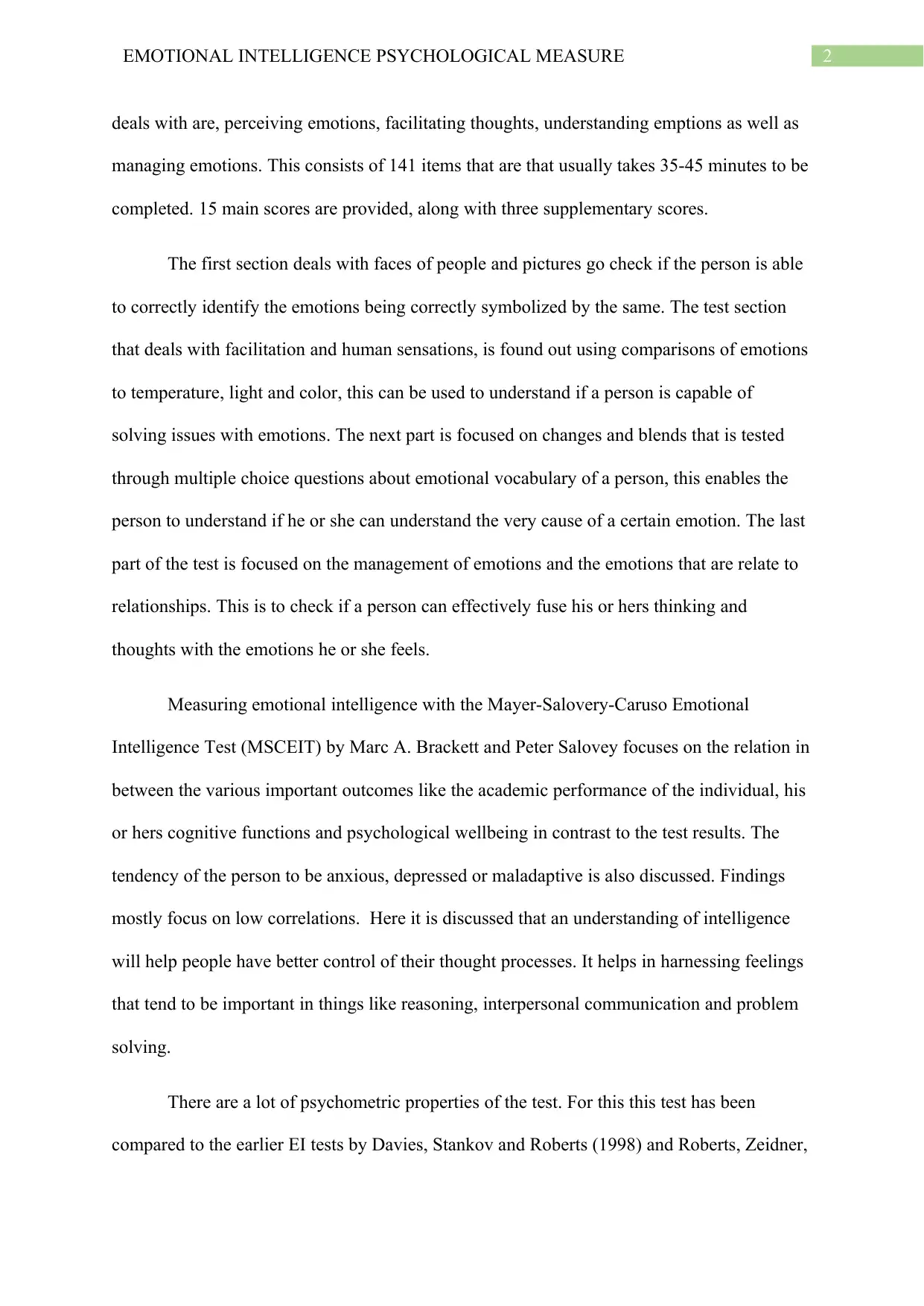
2EMOTIONAL INTELLIGENCE PSYCHOLOGICAL MEASURE
deals with are, perceiving emotions, facilitating thoughts, understanding emptions as well as
managing emotions. This consists of 141 items that are that usually takes 35-45 minutes to be
completed. 15 main scores are provided, along with three supplementary scores.
The first section deals with faces of people and pictures go check if the person is able
to correctly identify the emotions being correctly symbolized by the same. The test section
that deals with facilitation and human sensations, is found out using comparisons of emotions
to temperature, light and color, this can be used to understand if a person is capable of
solving issues with emotions. The next part is focused on changes and blends that is tested
through multiple choice questions about emotional vocabulary of a person, this enables the
person to understand if he or she can understand the very cause of a certain emotion. The last
part of the test is focused on the management of emotions and the emotions that are relate to
relationships. This is to check if a person can effectively fuse his or hers thinking and
thoughts with the emotions he or she feels.
Measuring emotional intelligence with the Mayer-Salovery-Caruso Emotional
Intelligence Test (MSCEIT) by Marc A. Brackett and Peter Salovey focuses on the relation in
between the various important outcomes like the academic performance of the individual, his
or hers cognitive functions and psychological wellbeing in contrast to the test results. The
tendency of the person to be anxious, depressed or maladaptive is also discussed. Findings
mostly focus on low correlations. Here it is discussed that an understanding of intelligence
will help people have better control of their thought processes. It helps in harnessing feelings
that tend to be important in things like reasoning, interpersonal communication and problem
solving.
There are a lot of psychometric properties of the test. For this this test has been
compared to the earlier EI tests by Davies, Stankov and Roberts (1998) and Roberts, Zeidner,
deals with are, perceiving emotions, facilitating thoughts, understanding emptions as well as
managing emotions. This consists of 141 items that are that usually takes 35-45 minutes to be
completed. 15 main scores are provided, along with three supplementary scores.
The first section deals with faces of people and pictures go check if the person is able
to correctly identify the emotions being correctly symbolized by the same. The test section
that deals with facilitation and human sensations, is found out using comparisons of emotions
to temperature, light and color, this can be used to understand if a person is capable of
solving issues with emotions. The next part is focused on changes and blends that is tested
through multiple choice questions about emotional vocabulary of a person, this enables the
person to understand if he or she can understand the very cause of a certain emotion. The last
part of the test is focused on the management of emotions and the emotions that are relate to
relationships. This is to check if a person can effectively fuse his or hers thinking and
thoughts with the emotions he or she feels.
Measuring emotional intelligence with the Mayer-Salovery-Caruso Emotional
Intelligence Test (MSCEIT) by Marc A. Brackett and Peter Salovey focuses on the relation in
between the various important outcomes like the academic performance of the individual, his
or hers cognitive functions and psychological wellbeing in contrast to the test results. The
tendency of the person to be anxious, depressed or maladaptive is also discussed. Findings
mostly focus on low correlations. Here it is discussed that an understanding of intelligence
will help people have better control of their thought processes. It helps in harnessing feelings
that tend to be important in things like reasoning, interpersonal communication and problem
solving.
There are a lot of psychometric properties of the test. For this this test has been
compared to the earlier EI tests by Davies, Stankov and Roberts (1998) and Roberts, Zeidner,
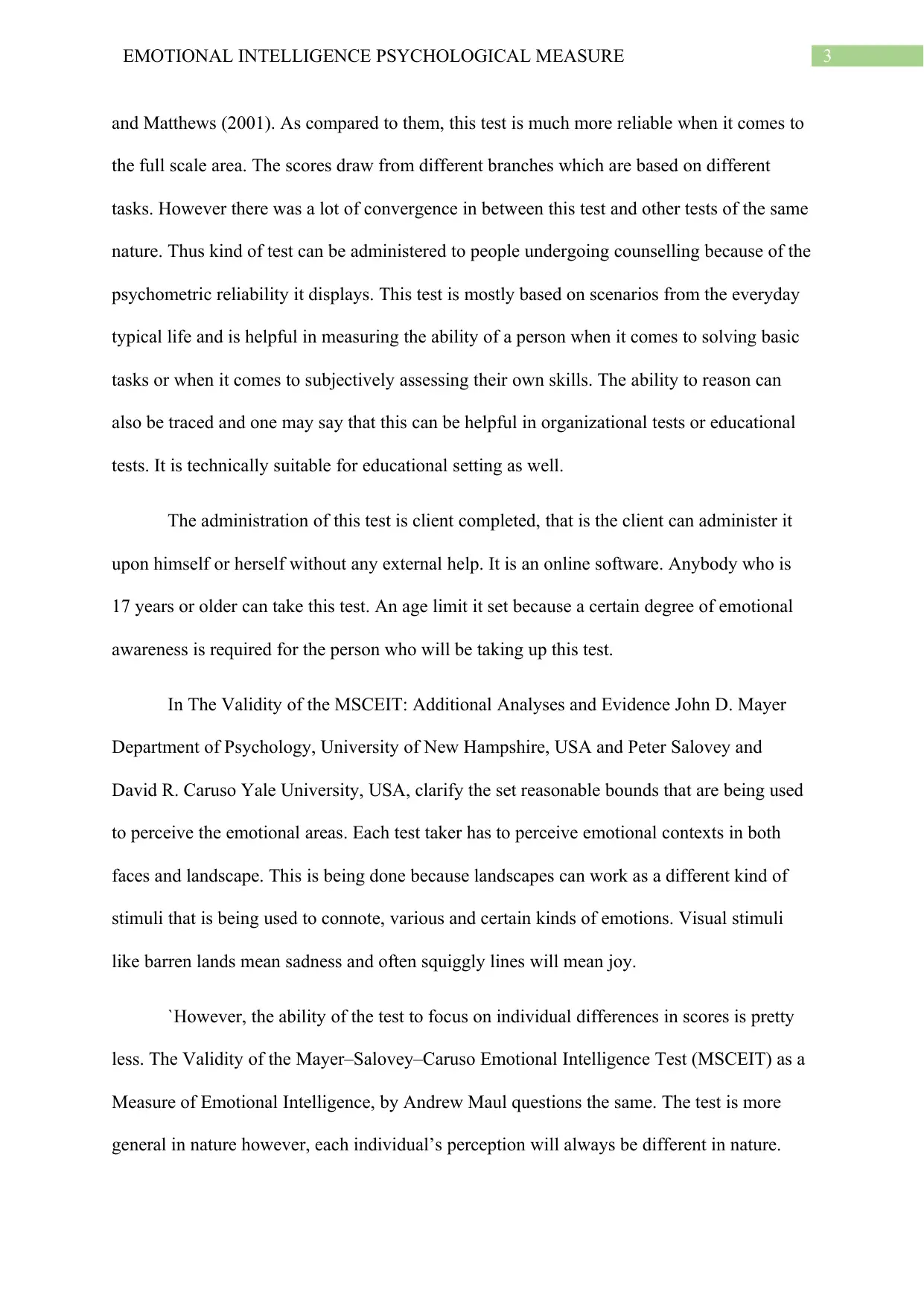
3EMOTIONAL INTELLIGENCE PSYCHOLOGICAL MEASURE
and Matthews (2001). As compared to them, this test is much more reliable when it comes to
the full scale area. The scores draw from different branches which are based on different
tasks. However there was a lot of convergence in between this test and other tests of the same
nature. Thus kind of test can be administered to people undergoing counselling because of the
psychometric reliability it displays. This test is mostly based on scenarios from the everyday
typical life and is helpful in measuring the ability of a person when it comes to solving basic
tasks or when it comes to subjectively assessing their own skills. The ability to reason can
also be traced and one may say that this can be helpful in organizational tests or educational
tests. It is technically suitable for educational setting as well.
The administration of this test is client completed, that is the client can administer it
upon himself or herself without any external help. It is an online software. Anybody who is
17 years or older can take this test. An age limit it set because a certain degree of emotional
awareness is required for the person who will be taking up this test.
In The Validity of the MSCEIT: Additional Analyses and Evidence John D. Mayer
Department of Psychology, University of New Hampshire, USA and Peter Salovey and
David R. Caruso Yale University, USA, clarify the set reasonable bounds that are being used
to perceive the emotional areas. Each test taker has to perceive emotional contexts in both
faces and landscape. This is being done because landscapes can work as a different kind of
stimuli that is being used to connote, various and certain kinds of emotions. Visual stimuli
like barren lands mean sadness and often squiggly lines will mean joy.
`However, the ability of the test to focus on individual differences in scores is pretty
less. The Validity of the Mayer–Salovey–Caruso Emotional Intelligence Test (MSCEIT) as a
Measure of Emotional Intelligence, by Andrew Maul questions the same. The test is more
general in nature however, each individual’s perception will always be different in nature.
and Matthews (2001). As compared to them, this test is much more reliable when it comes to
the full scale area. The scores draw from different branches which are based on different
tasks. However there was a lot of convergence in between this test and other tests of the same
nature. Thus kind of test can be administered to people undergoing counselling because of the
psychometric reliability it displays. This test is mostly based on scenarios from the everyday
typical life and is helpful in measuring the ability of a person when it comes to solving basic
tasks or when it comes to subjectively assessing their own skills. The ability to reason can
also be traced and one may say that this can be helpful in organizational tests or educational
tests. It is technically suitable for educational setting as well.
The administration of this test is client completed, that is the client can administer it
upon himself or herself without any external help. It is an online software. Anybody who is
17 years or older can take this test. An age limit it set because a certain degree of emotional
awareness is required for the person who will be taking up this test.
In The Validity of the MSCEIT: Additional Analyses and Evidence John D. Mayer
Department of Psychology, University of New Hampshire, USA and Peter Salovey and
David R. Caruso Yale University, USA, clarify the set reasonable bounds that are being used
to perceive the emotional areas. Each test taker has to perceive emotional contexts in both
faces and landscape. This is being done because landscapes can work as a different kind of
stimuli that is being used to connote, various and certain kinds of emotions. Visual stimuli
like barren lands mean sadness and often squiggly lines will mean joy.
`However, the ability of the test to focus on individual differences in scores is pretty
less. The Validity of the Mayer–Salovey–Caruso Emotional Intelligence Test (MSCEIT) as a
Measure of Emotional Intelligence, by Andrew Maul questions the same. The test is more
general in nature however, each individual’s perception will always be different in nature.
Secure Best Marks with AI Grader
Need help grading? Try our AI Grader for instant feedback on your assignments.
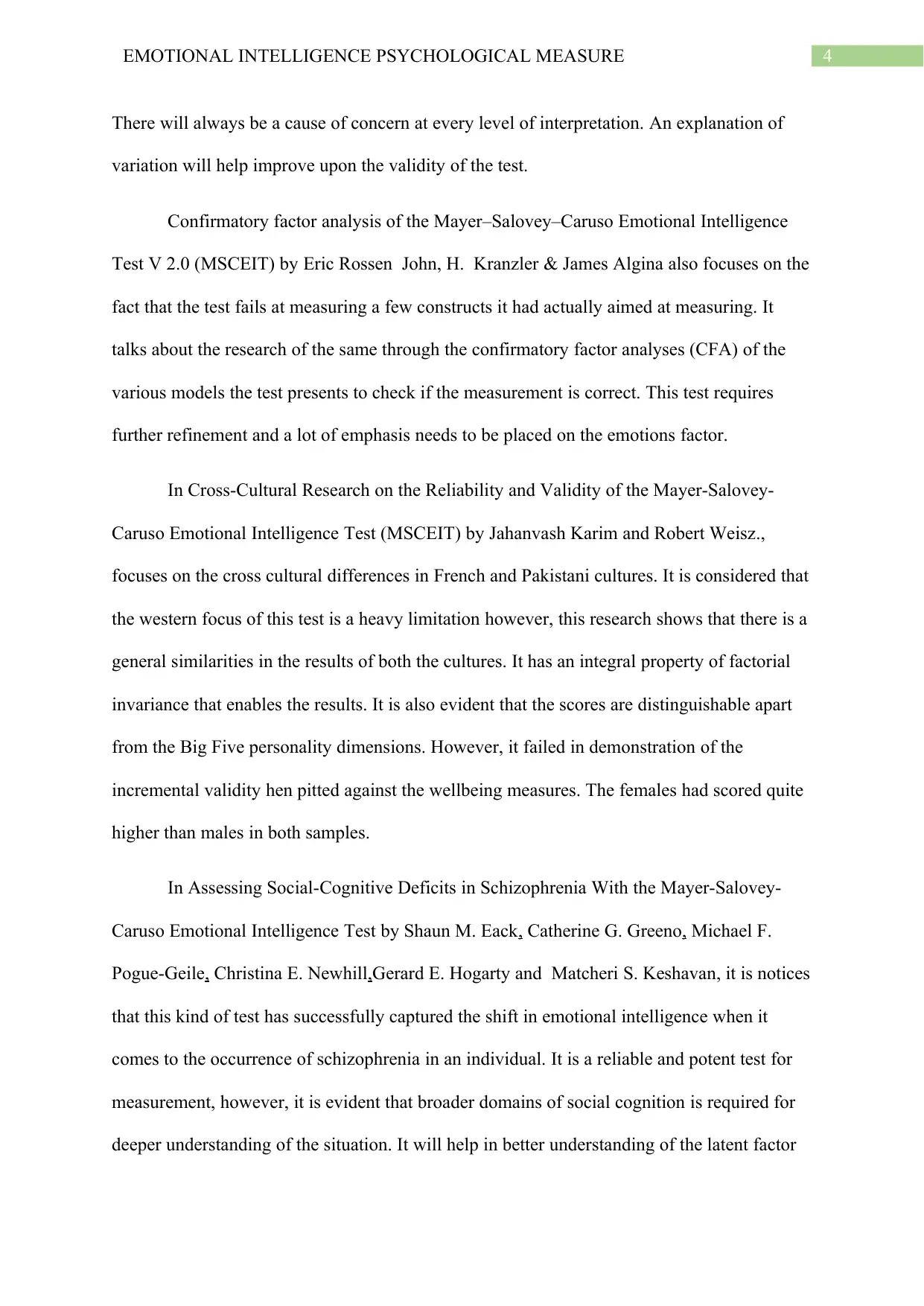
4EMOTIONAL INTELLIGENCE PSYCHOLOGICAL MEASURE
There will always be a cause of concern at every level of interpretation. An explanation of
variation will help improve upon the validity of the test.
Confirmatory factor analysis of the Mayer–Salovey–Caruso Emotional Intelligence
Test V 2.0 (MSCEIT) by Eric Rossen John, H. Kranzler & James Algina also focuses on the
fact that the test fails at measuring a few constructs it had actually aimed at measuring. It
talks about the research of the same through the confirmatory factor analyses (CFA) of the
various models the test presents to check if the measurement is correct. This test requires
further refinement and a lot of emphasis needs to be placed on the emotions factor.
In Cross-Cultural Research on the Reliability and Validity of the Mayer-Salovey-
Caruso Emotional Intelligence Test (MSCEIT) by Jahanvash Karim and Robert Weisz.,
focuses on the cross cultural differences in French and Pakistani cultures. It is considered that
the western focus of this test is a heavy limitation however, this research shows that there is a
general similarities in the results of both the cultures. It has an integral property of factorial
invariance that enables the results. It is also evident that the scores are distinguishable apart
from the Big Five personality dimensions. However, it failed in demonstration of the
incremental validity hen pitted against the wellbeing measures. The females had scored quite
higher than males in both samples.
In Assessing Social-Cognitive Deficits in Schizophrenia With the Mayer-Salovey-
Caruso Emotional Intelligence Test by Shaun M. Eack, Catherine G. Greeno, Michael F.
Pogue-Geile, Christina E. Newhill,Gerard E. Hogarty and Matcheri S. Keshavan, it is notices
that this kind of test has successfully captured the shift in emotional intelligence when it
comes to the occurrence of schizophrenia in an individual. It is a reliable and potent test for
measurement, however, it is evident that broader domains of social cognition is required for
deeper understanding of the situation. It will help in better understanding of the latent factor
There will always be a cause of concern at every level of interpretation. An explanation of
variation will help improve upon the validity of the test.
Confirmatory factor analysis of the Mayer–Salovey–Caruso Emotional Intelligence
Test V 2.0 (MSCEIT) by Eric Rossen John, H. Kranzler & James Algina also focuses on the
fact that the test fails at measuring a few constructs it had actually aimed at measuring. It
talks about the research of the same through the confirmatory factor analyses (CFA) of the
various models the test presents to check if the measurement is correct. This test requires
further refinement and a lot of emphasis needs to be placed on the emotions factor.
In Cross-Cultural Research on the Reliability and Validity of the Mayer-Salovey-
Caruso Emotional Intelligence Test (MSCEIT) by Jahanvash Karim and Robert Weisz.,
focuses on the cross cultural differences in French and Pakistani cultures. It is considered that
the western focus of this test is a heavy limitation however, this research shows that there is a
general similarities in the results of both the cultures. It has an integral property of factorial
invariance that enables the results. It is also evident that the scores are distinguishable apart
from the Big Five personality dimensions. However, it failed in demonstration of the
incremental validity hen pitted against the wellbeing measures. The females had scored quite
higher than males in both samples.
In Assessing Social-Cognitive Deficits in Schizophrenia With the Mayer-Salovey-
Caruso Emotional Intelligence Test by Shaun M. Eack, Catherine G. Greeno, Michael F.
Pogue-Geile, Christina E. Newhill,Gerard E. Hogarty and Matcheri S. Keshavan, it is notices
that this kind of test has successfully captured the shift in emotional intelligence when it
comes to the occurrence of schizophrenia in an individual. It is a reliable and potent test for
measurement, however, it is evident that broader domains of social cognition is required for
deeper understanding of the situation. It will help in better understanding of the latent factor
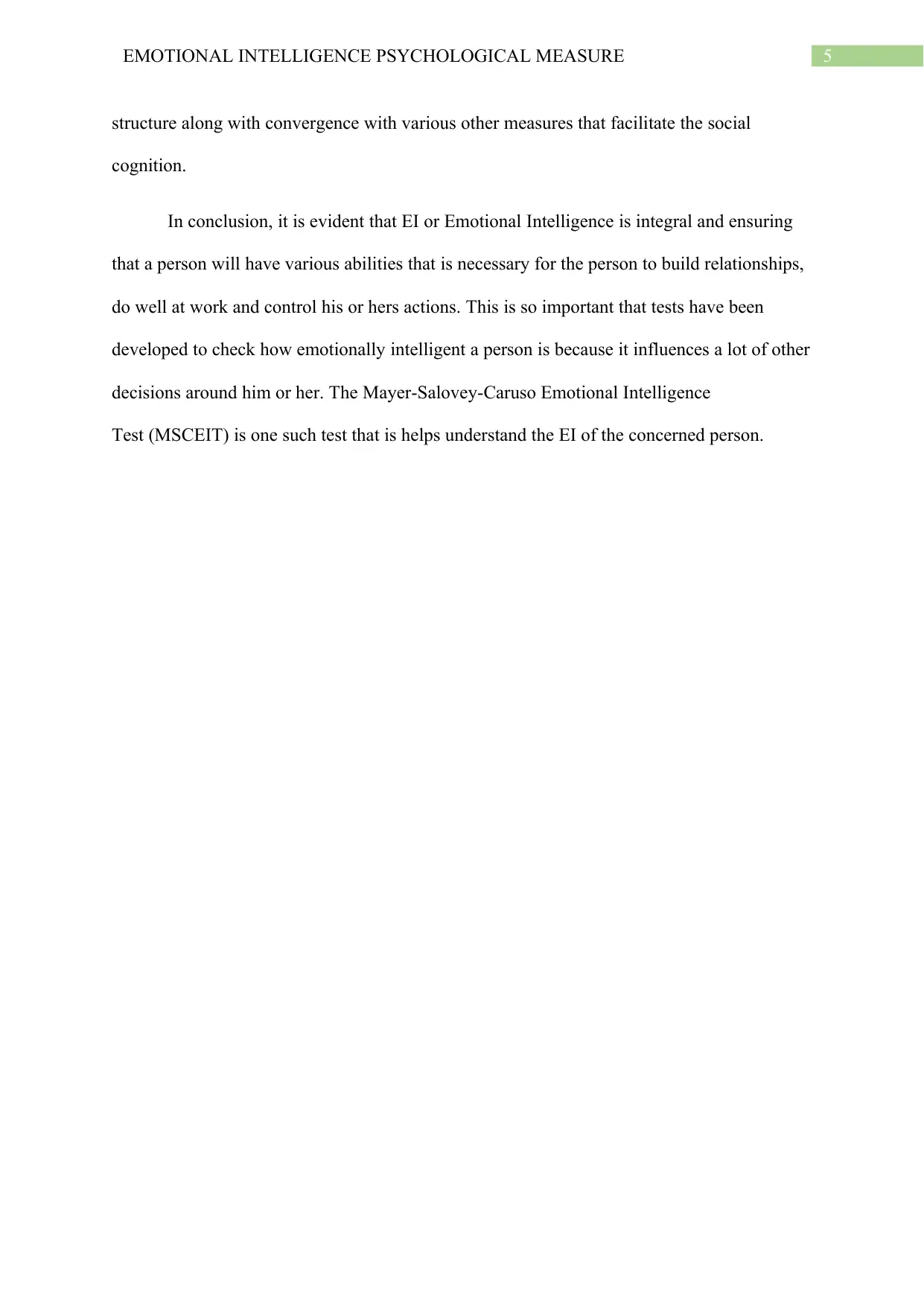
5EMOTIONAL INTELLIGENCE PSYCHOLOGICAL MEASURE
structure along with convergence with various other measures that facilitate the social
cognition.
In conclusion, it is evident that EI or Emotional Intelligence is integral and ensuring
that a person will have various abilities that is necessary for the person to build relationships,
do well at work and control his or hers actions. This is so important that tests have been
developed to check how emotionally intelligent a person is because it influences a lot of other
decisions around him or her. The Mayer-Salovey-Caruso Emotional Intelligence
Test (MSCEIT) is one such test that is helps understand the EI of the concerned person.
structure along with convergence with various other measures that facilitate the social
cognition.
In conclusion, it is evident that EI or Emotional Intelligence is integral and ensuring
that a person will have various abilities that is necessary for the person to build relationships,
do well at work and control his or hers actions. This is so important that tests have been
developed to check how emotionally intelligent a person is because it influences a lot of other
decisions around him or her. The Mayer-Salovey-Caruso Emotional Intelligence
Test (MSCEIT) is one such test that is helps understand the EI of the concerned person.
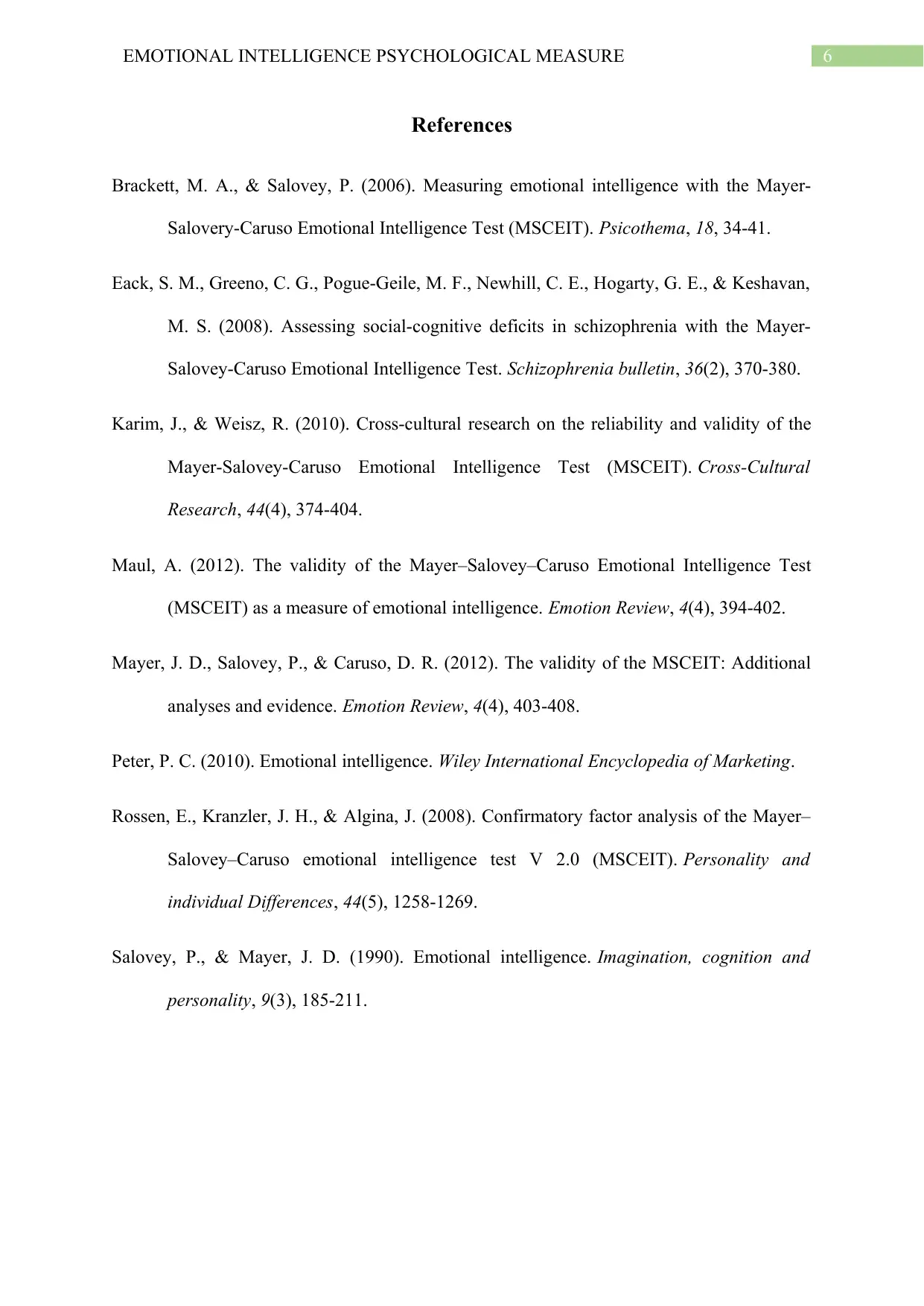
6EMOTIONAL INTELLIGENCE PSYCHOLOGICAL MEASURE
References
Brackett, M. A., & Salovey, P. (2006). Measuring emotional intelligence with the Mayer-
Salovery-Caruso Emotional Intelligence Test (MSCEIT). Psicothema, 18, 34-41.
Eack, S. M., Greeno, C. G., Pogue-Geile, M. F., Newhill, C. E., Hogarty, G. E., & Keshavan,
M. S. (2008). Assessing social-cognitive deficits in schizophrenia with the Mayer-
Salovey-Caruso Emotional Intelligence Test. Schizophrenia bulletin, 36(2), 370-380.
Karim, J., & Weisz, R. (2010). Cross-cultural research on the reliability and validity of the
Mayer-Salovey-Caruso Emotional Intelligence Test (MSCEIT). Cross-Cultural
Research, 44(4), 374-404.
Maul, A. (2012). The validity of the Mayer–Salovey–Caruso Emotional Intelligence Test
(MSCEIT) as a measure of emotional intelligence. Emotion Review, 4(4), 394-402.
Mayer, J. D., Salovey, P., & Caruso, D. R. (2012). The validity of the MSCEIT: Additional
analyses and evidence. Emotion Review, 4(4), 403-408.
Peter, P. C. (2010). Emotional intelligence. Wiley International Encyclopedia of Marketing.
Rossen, E., Kranzler, J. H., & Algina, J. (2008). Confirmatory factor analysis of the Mayer–
Salovey–Caruso emotional intelligence test V 2.0 (MSCEIT). Personality and
individual Differences, 44(5), 1258-1269.
Salovey, P., & Mayer, J. D. (1990). Emotional intelligence. Imagination, cognition and
personality, 9(3), 185-211.
References
Brackett, M. A., & Salovey, P. (2006). Measuring emotional intelligence with the Mayer-
Salovery-Caruso Emotional Intelligence Test (MSCEIT). Psicothema, 18, 34-41.
Eack, S. M., Greeno, C. G., Pogue-Geile, M. F., Newhill, C. E., Hogarty, G. E., & Keshavan,
M. S. (2008). Assessing social-cognitive deficits in schizophrenia with the Mayer-
Salovey-Caruso Emotional Intelligence Test. Schizophrenia bulletin, 36(2), 370-380.
Karim, J., & Weisz, R. (2010). Cross-cultural research on the reliability and validity of the
Mayer-Salovey-Caruso Emotional Intelligence Test (MSCEIT). Cross-Cultural
Research, 44(4), 374-404.
Maul, A. (2012). The validity of the Mayer–Salovey–Caruso Emotional Intelligence Test
(MSCEIT) as a measure of emotional intelligence. Emotion Review, 4(4), 394-402.
Mayer, J. D., Salovey, P., & Caruso, D. R. (2012). The validity of the MSCEIT: Additional
analyses and evidence. Emotion Review, 4(4), 403-408.
Peter, P. C. (2010). Emotional intelligence. Wiley International Encyclopedia of Marketing.
Rossen, E., Kranzler, J. H., & Algina, J. (2008). Confirmatory factor analysis of the Mayer–
Salovey–Caruso emotional intelligence test V 2.0 (MSCEIT). Personality and
individual Differences, 44(5), 1258-1269.
Salovey, P., & Mayer, J. D. (1990). Emotional intelligence. Imagination, cognition and
personality, 9(3), 185-211.
1 out of 7
Related Documents
Your All-in-One AI-Powered Toolkit for Academic Success.
+13062052269
info@desklib.com
Available 24*7 on WhatsApp / Email
![[object Object]](/_next/static/media/star-bottom.7253800d.svg)
Unlock your academic potential
© 2024 | Zucol Services PVT LTD | All rights reserved.





